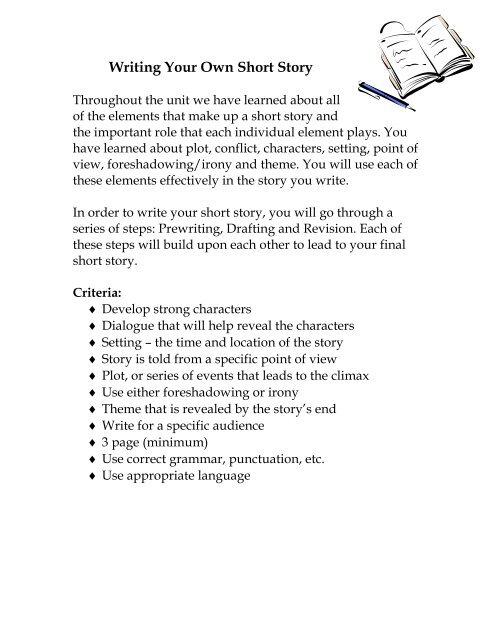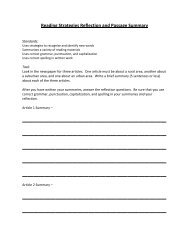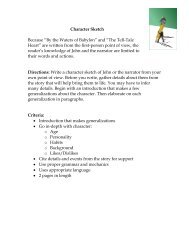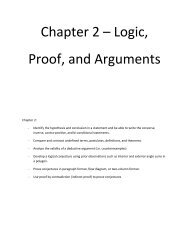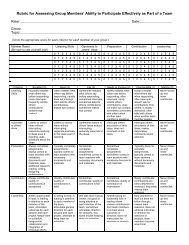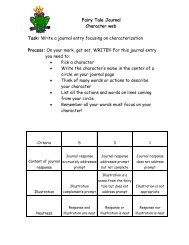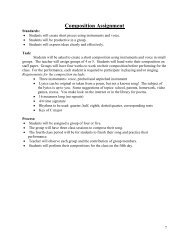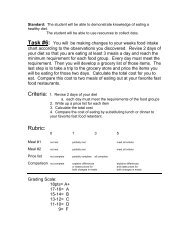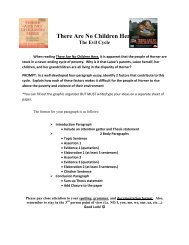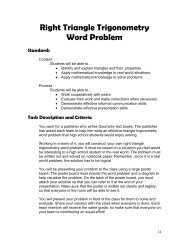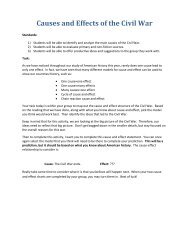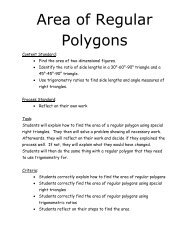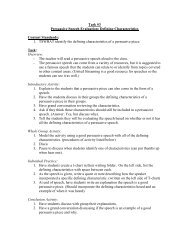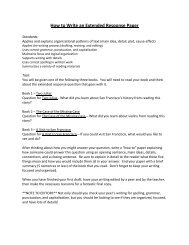Writing Your Own Short Story
Writing Your Own Short Story
Writing Your Own Short Story
You also want an ePaper? Increase the reach of your titles
YUMPU automatically turns print PDFs into web optimized ePapers that Google loves.
<strong>Writing</strong> <strong>Your</strong> <strong>Own</strong> <strong>Short</strong> <strong>Story</strong><br />
Throughout the unit we have learned about all<br />
of the elements that make up a short story and<br />
the important role that each individual element plays. You<br />
have learned about plot, conflict, characters, setting, point of<br />
view, foreshadowing/irony and theme. You will use each of<br />
these elements effectively in the story you write.<br />
In order to write your short story, you will go through a<br />
series of steps: Prewriting, Drafting and Revision. Each of<br />
these steps will build upon each other to lead to your final<br />
short story.<br />
Criteria:<br />
Develop strong characters<br />
Dialogue that will help reveal the characters<br />
Setting – the time and location of the story<br />
<strong>Story</strong> is told from a specific point of view<br />
Plot, or series of events that leads to the climax<br />
Use either foreshadowing or irony<br />
Theme that is revealed by the story’s end<br />
Write for a specific audience<br />
3 page (minimum)<br />
Use correct grammar, punctuation, etc.<br />
Use appropriate language
Prewriting<br />
Sometimes topics for short stories come quickly to writers.<br />
When that does not happen, writers must use various<br />
strategies to find ideas. If you are struggling for an idea,<br />
try sketching a character. Use your imagination to create<br />
your characters.<br />
Gathering Details about Characters<br />
Characters are the people, animals, alien life-forms, or<br />
other creatures that take part in the action of a narrative.<br />
Before you begin drafting, get to know the characters you<br />
will develop.<br />
Use the chart below to create and examine 2 characters to<br />
learn who he, she, or it is. Decide your character’s likes<br />
and dislikes, dreams and fears, and what others think of<br />
them.<br />
Character<br />
Appearance<br />
Actions<br />
What the Character Says<br />
Thoughts<br />
Likes<br />
Dislikes<br />
Dreams<br />
Fears<br />
What Others Think of<br />
the Character
Prewriting Rubric<br />
Character # 1<br />
3 2 1 0<br />
Character Successfully Gave Barely Did not give<br />
Development gave enough details to gave any details to create<br />
(x2)<br />
details to<br />
create a<br />
create a<br />
character<br />
details to<br />
create a<br />
an effective<br />
character<br />
character<br />
character<br />
Completeness Filled in all Filled in Did not Did not fill in<br />
spots on the most spots fill in chart<br />
chart on the more<br />
chart than half<br />
of the<br />
spots<br />
Character # 2<br />
3 2 1 0<br />
Character Successfully Gave Barely Did not give<br />
Development gave enough details to gave any details to create<br />
(x2)<br />
details to<br />
create a<br />
create a<br />
character<br />
details to<br />
create a<br />
an effective<br />
character<br />
character<br />
character<br />
Completeness Filled in all Filled in Did not Did not fill in<br />
spots on the most spots fill in chart<br />
chart on the more<br />
chart than half<br />
of the<br />
spots
Drafting<br />
Before you begin drafting your story, keep your central<br />
conflict in mind and shape your story around it. An effective<br />
plot has the following components:<br />
Climax<br />
Rising Action Falling Action<br />
Exposition Resolution<br />
You know what each part of plot is made up of from earlier<br />
assignments. You will have an easier time drafting your<br />
essay once you have identified each of these parts of plot in<br />
your story.<br />
To get started:<br />
Create your own Plot Diagram.<br />
Fill in the events of your story from beginning to end<br />
Correctly identify which events are the 5 parts of plot<br />
Include details from your story<br />
Once you are finished with your plot diagram, you may<br />
begin writing your rough draft. Use your plot diagram and<br />
character sketches in your writing process.
Presentation Plot<br />
diagram is<br />
neat,<br />
organized<br />
and easy to<br />
follow<br />
Events Events are<br />
displayed<br />
in logical<br />
order<br />
Parts of Plot Successfully<br />
labeled and<br />
identified<br />
all parts of<br />
plot<br />
Details Successfully<br />
gave<br />
enough<br />
details to<br />
enhance<br />
plot<br />
Plot Diagram<br />
Rubric<br />
3 2 1 0<br />
Plot<br />
diagram is<br />
organized,<br />
can be<br />
followed<br />
One event<br />
is not in<br />
logical<br />
order<br />
Labeled<br />
and<br />
identified<br />
parts of<br />
plot with<br />
one error<br />
Gave<br />
details to<br />
enhance<br />
plot<br />
Plot diagram<br />
is<br />
unorganized,<br />
and can be<br />
followed<br />
with<br />
difficulty<br />
Two or more<br />
events are<br />
not in logical<br />
order<br />
Labeled and<br />
identified<br />
parts of plot<br />
with 2 or<br />
more errors<br />
Barely gave<br />
any details<br />
to enhance<br />
plot<br />
Plot<br />
diagram is<br />
not legible<br />
Events are<br />
not given<br />
in logical<br />
order to<br />
the story<br />
Did not<br />
label parts<br />
of plot on<br />
timeline<br />
Did not<br />
give<br />
details to<br />
enhance<br />
plot
Revision<br />
Now that you have written your rough draft, you will<br />
participate in a peer editing activity. For this activity you are<br />
to:<br />
Exchange papers with a partner; read through your<br />
partner’s essay carefully<br />
Correct any grammatical errors as you read the essay<br />
When you are done, fill out the Rubric for<br />
Assessment<br />
Once the rubric has been completed pass it back to<br />
your partner and discuss the ratings you have given<br />
REMEMBER to provide constructive comments to<br />
your partner<br />
Rubric for Assessment<br />
Criteria Not Very Very<br />
Does the main character<br />
undergo a change or<br />
learning experience?<br />
How well is the setting<br />
described?<br />
Are there clear plot events<br />
that lead to a climax?<br />
How clearly is the theme<br />
revealed?<br />
How effective is the<br />
descriptive language?<br />
1 2 3 4 5<br />
1 2 3 4 5<br />
1 2 3 4 5<br />
1 2 3 4 5<br />
1 2 3 4 5
Write your <strong>Own</strong> <strong>Short</strong> <strong>Story</strong><br />
Rubric<br />
4 3 2 1<br />
Audience/Purpose Presents details<br />
targeted at a unique<br />
audience; successfully<br />
narrates the events of a<br />
story<br />
Plot<br />
(x2)<br />
Characters<br />
(x2)<br />
Point of View<br />
(x2)<br />
Dialogue &<br />
Elaboration<br />
(x2)<br />
Presents events that<br />
create a clear narrative<br />
Successfully goes indepth<br />
with<br />
description; clearly<br />
covers all aspects of<br />
character<br />
Writes from a<br />
consistent point of<br />
view<br />
Contains details that<br />
provide insight to<br />
character; contains<br />
dialogue that reveals<br />
characters and furthers<br />
the plot<br />
Grammar Contains no errors in<br />
grammar, punctuation<br />
and spelling<br />
Use of Language Uses fresh word choice<br />
and tone to reveal<br />
story’s setting and<br />
character<br />
Page Length Meets required page<br />
length<br />
Presents details<br />
suited to an<br />
audience; narrates<br />
the events of a story<br />
Presents sequence<br />
of events<br />
Goes in-depth with<br />
description; covers<br />
all aspects of<br />
character<br />
Told from a specific<br />
point of view<br />
Contains details and<br />
dialogue that<br />
develop characters<br />
Contains few errors<br />
in grammar,<br />
punctuation, and<br />
spelling<br />
Uses interesting and<br />
fresh word choices<br />
Presents few<br />
details suited to<br />
an audience;<br />
some ides<br />
conflict with<br />
narration of story<br />
Presents a<br />
confusing<br />
sequence of<br />
events<br />
Includes some<br />
description;<br />
covers some<br />
aspects of<br />
character<br />
Contains<br />
inconsistent<br />
points of view<br />
Contains<br />
characters and<br />
setting; contains<br />
some dialogue<br />
Contains some<br />
errors in<br />
grammar,<br />
punctuation, and<br />
spelling<br />
Uses clichés and<br />
unoriginal<br />
expressions<br />
Supports no<br />
purpose; is not<br />
written for a<br />
specific audience<br />
Presents no logical<br />
order<br />
Does not go indepth<br />
with<br />
description; does<br />
not cover all<br />
aspects of<br />
character<br />
Uses an<br />
inconsistent point<br />
of view<br />
Contains few or no<br />
details to develop<br />
characters or<br />
setting; no<br />
dialogue provided<br />
Contains many<br />
errors in grammar,<br />
punctuation, and<br />
spelling<br />
Uses uninspired<br />
word choices<br />
-------------------- -------------------- Does not meet<br />
required page<br />
length


